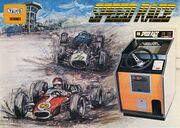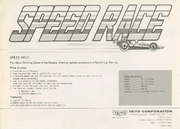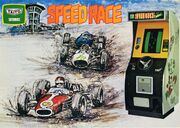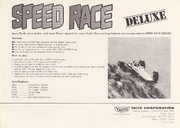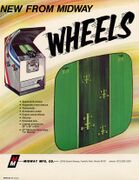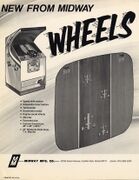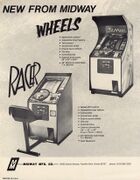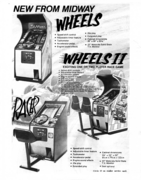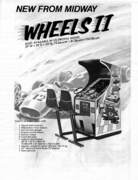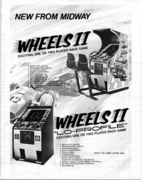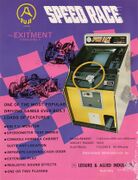Speed Race
Speed Race is a top-down racing game produced by Taito Corporation in 1974 under their Taitronics label. The game is notable as an early video racing game, establishing a format and a franchise which persisted for several years. It features the first use of an endless world through an early method of scrolling graphics.
The game was licensed to Midway Mfg in 1975 and released as Wheels in the US where it became a big success in the early video game market. Wheels features the addition of the score and the time being integrated into the video display at the top of the screen as well as a change of the gear shift to a lever which controlled the maximum acceleration of the car.
Gameplay[edit]
Players control an on screen car via a steering wheel, an acceleration pedal, and a gear shift to get the most points by continuously driving along the road within the time limit. Several features of the game are not portrayed by the video screen but are instead peripheral to the screen on the cabinet. Scores for the first and second players are shown via a set of LED displays as well as the time left remaining in the round. In the upright and deluxe versions of the game, there is also a speedometer tracking the player's trajectory. Players can extend their game time by reaching a particular score. The game features two-player trade-off multiplayer.
The scrolling in Speed Race is achieved by shifting a continuous loop of enemy vehicles off the top of the screen and on from below (this is visible in the game's idle attract mode). Lines on the side of the road also constantly move with the relative speed of the vehicle. Because there is not and variance in scenery, some have argued whether this can be considered a scrolling video game.
History[edit]
Designer Tomohiro Nishikado had been inspired in his youth by the electro-mechanical driving game Mini Drive by Kansai Seiki (Kasco), one of his favorite coin-operated games. His first electro-mechanical game design for Taito was Super Road Seven, a combination of the technology used in Kasco's Speedway and the model car racing of Mini Drive.
In 1974, Nishikado was introduced to Atari's Gran Trak 10. He was unimpressed with the gameplay which he felt was too slow and precise compared to the speedy gameplay of the electro-mechanical driving games. He endeavored to create a game which replicated the experience of Super Road Seven in video game form, utilizing the transistor-transistor logic design he had used in his previous games.
As Speed Race was ready to be manufactured, Taito management decided that the expense of the game warranted a play price of 100 yen rather than the standard 50 yen. Worried that this would hurt the success of the game with players, Nishikado added a dip switch option for an operator to charge 50 yen as an option. The game became a success even with the 100 yen price point with few operators making the change.
International Releases[edit]
Taito licensed Speed Race to Midway Mfg who had previously released Taito's TV Basketball. The game was unchanged from the original, save for a different cabinet design. Released as Wheels in 1975, it was very successful for Midway and was one of the highest-selling cabinets of 1975 with 2,400 cabinets sold. Midway also released the game as Racer with the only difference being a seat attached to the cabinet.
In Australia, the game was released under the Fuji Japan logo by Leisure & Allied Industries.
Series[edit]
Speed Race was the first in a series of games released by Taito until 1985.
Legacy[edit]
The gameplay of Speed Race was copied and iterated by many other companies who created video racing games.
Mattel's Auto Race handheld game largely copies the model of Speed Race.
Announcement[edit]
Advertisement[edit]
Japanese Release[edit]
US Release[edit]
Australian Release[edit]
Game credits[edit]
- Game Designer, Hardware Designer
- Tomohiro Nishikado



